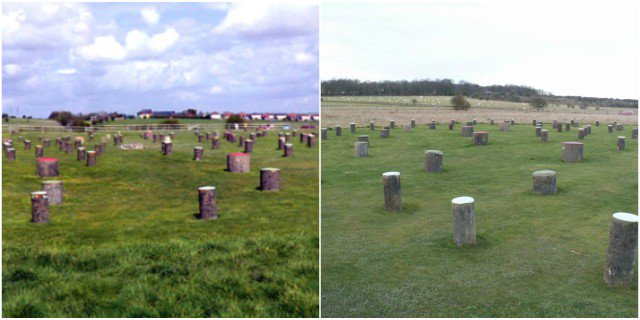tonehenge’s less popular neighbor, Woodhenge, is just as intriguing and mysterious as Europe’s most famous prehistoric monument.
Located just a couple of miles away from Stonehenge, near Amesbury, England, the site was built around 2300 BC and remained in use for the next 500 years. Woodhenge was discovered in the early 19th century by Richard Colt Hoare.
He described it as earthworks and as the mutilated remains of an enormous Druid barrow. It was formerly called Dough Cover and remained like that until 1926 when RAF pilot Squadron Leader Gilbert Install took a rather strange aerial photograph that showed a series of dark spots in a crop of wheat.
Archaeologists Maud and Howard Cunnington excavated the site between 1926-28 and came to the conclusion that it was the remains of a large burial mound surrounded first by six concentric rings of postholes and then by an earthen bank and ditch.


According to Maud Cunnington, the burial was of a three-year-old child whose skull had been split in two with an ax. The Welsh archaeologist interpreted this as a child sacrifice ritual, but there is a possibility that the weight of the earth on the body might have caused the damage.
The remains were taken to London to be examined but, unfortunately, they were destroyed during World War II, making re-examination impossible. Cunnington also discovered a skeleton of a teenager in the Eastern section of the ditch.
There is also a possibility that the six concentric rings of postholes – which do not describe a perfect circle – may have been used for defensive purposes and a building may have been built around an inner courtyard since the post holes of the third ring appear to be larger than those in the other rings.

There is evidence that shows that in the area around Woodhenge there was a settlement throughout the Iron Age and the Roman period and it is thought that the banks and ditches served a defensive purpose at the time.
Along with the human remains that have been discovered at the site, there was also pottery and other small objects. The shape of the pottery vessels is clear evidence that the structure was probably built during the Beaker period (c. 2900 – 1800 BC).

There are 168 post holes, and most of them held wooden posts, although now they are marked by modern concrete blocks to show their size and position. Cunnington claimed that she had found evidence of a pair of standing stones that were placed between the second and third post hole rings and excavations in the 2000s indeed showed that there were at least five standing stones on the site.
No one knows for sure what the purpose of these fascinating concentric rings of postholes was, but that just adds more mystery and makes this site as interesting as its famous neighbor, Stonehenge.
